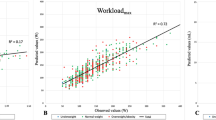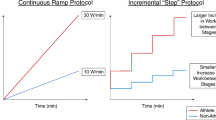Abstract
Developing a standardized protocol for pediatric exercise laboratories is challenging. Our objective was to report normal pediatric values for a continuous non-steady state cycle ergometer ramp protocol to achieve 8–10 min of exercise based on sex and weight. One hundred seventeen patients (117) [mean age 13 ± 2.8 years, range 7–18 years (51% male)] referred for chest pain with normal cardiac evaluation underwent cardiopulmonary testing on a cycle ergometer. Patients entered one of the four continuous ramp protocols (10, 15, 20, and 25 W/min ramp) to achieve an expected peak workload of 3 W/kg at an increase of 0.3 to 0.35 W/kg/min. Exercise test outcomes measured included duration, peak heart rate, work, respiratory exchange ratio, peak oxygen consumption, peak blood pressure, and ventilatory anaerobic threshold. An exercise duration of 8–10 min was achieved in a majority of the study population; however, interactions with age (older, longer duration) and sex (males, longer duration) were present. Using our algorithm (0.3–0.35 W/kg × weight), we demonstrated four non-steady state ramp bike ergometer protocols (10, 15, 20, and 25 W/min) that can be applied to males and females of different ages and weights to achieve an exercise duration of 8–10 min.

Similar content being viewed by others
References
Wasserman K, Hansen JE, Sue DY, Casabur R, Whipp B (1999) Principles of exercise testing and interpretation: including pathophysiology and clinical applications, 3rd edn. Lippincott Williams and Wilkins, Philadelphia
Paridon S, Alpert BS, Boas SR, Cabrera ME, Caldarera LL, Daniels SR, Kimball TR, Knilans TK, Nixon PA, Rhodes J, Yetman AT, American Heart Association Council on Cardiovascular Disease in the Young, Committee on Atherosclerosis, Hypertension, and Obesity in Youth (2006) Clinical stress testing in the pediatric age group: a statement from the American Heart Association Council on Cardiovascular Disease in the Young, Committee on Atherosclerosis, Hypertension, and Obesity in youth. Circulation 113:1905–1920
Rowland TW (1993) Aerobic exercise testing protocols. In: Rowland TW (ed) Pediatric laboratory exercise testing: clinical guidelines. Human Kinetics, Champaign, pp 19–41
Tomassoni TL (1993) Conducting the pediatric exercise test. In: Rowland TW (ed) Pediatric laboratory exercise testing: clinical guidelines. Human Kinetics, Champaign, pp 1–17
Blais S, Berbari J, Counil FP, Dallaire F (2015) A systematic review of reference values in pediatric cardiopulmonary exercise testing. Pediatr Cardiol 36:1553–1564
Cooper DM, Weiler-Ravell D, Whipp BJ, Wasserman K (1984) Aerobic parameters of exercise as a function of body size during growth in children. J Appl Physiol Respir Environ Exerc Physiol 56:628–634
Godfrey S, Davies CT, Wozniak E, Barnes CA (1971) Cardio-respiratory response to exercise in normal children. Clin Sci 40(5):419–431
Tanner CS, Heise CT, Barber G (1991) Correlation of the physiologic parameters of a continuous ramp versus an incremental James exercise protocol in normal children. Am J Cardiol 67:309–312
Ten Harkel ADJ, Takken T, Van Osch-Gevers M, Helbing WA (2011) Normal values for cardiopulmonary exercise testing in children. Eur J Cardiovasc Prev Rehabil 18:48–54
Marshall WQ (1978) Puberty. In: Falkner F, Tanner JM (eds) Human growth, vol 2. Plenum, New York, pp 141–178
Miller MR, Hankinson J, Brusasco V, Burgos F, Casaburi R, Coates A, Crapo R, Enright P, van der Grinten CP, Gustafsson P, Jensen R, Johnson DC, MacIntyre N, McKay R, Navajas D, Pedersen OF, Pellegrino R, Viegi G, Wanger J, ATS/ERS Task Force (2005) Standardisation of spirometry. Eur Respir J 26:319–338
Petzl DH, Haber P, Schuster E, Popow C, Haschke F (1988) Reliability of estimation of maximum performance capacity on the basis of submaximum ergometric stress tests in children 10–14 years old. Eur J Pediatr 147:174–178
Brooks GA, Fahey TD, Baldwin KM (1984) Sex difference in physical performance. In: Brooks GA, Fahey TD (eds) Exercise physiology: human bioenergetics and its applications, 1st edn. Wiley, New York, pp 637–659
Beaver WL, Wasserman K, Whipp BJ (1986) A new method for detecting anaerobic threshold by gas exchange. J Appl Physiol 60:2020–2027
Center for Disease Control and Prevention (n.d.) Body mass index: considerations for practitioners. https://www.cdc.gov/obesity/downloads/BMIforPactitioners.pdf. Accessed 2 April 2017
Center for Disease Control and Prevention (2017) Clinical growth charts. National Center for Health Statistics. http://www.cdc.gov/growthcharts/clinical_charts.htm. Accessed 14 Sep 2017
Ogden CL, Carroll MD, Curtin LR, Lamb MM, Flegal KM (2010) Prevalence of high body mass index in US children and adolescents, 2007–2008. JAMA 303:242–249
Centers for Disease Control and Prevention (2017) National Health and Nutrition Examination (NHANES). http://www.cdc.gov/nchs/nhanes/index.htm. Accessed 20 Sep 2016
Freedson PS, Goodman TL (1993) Measurement of oxygen consumption. In: Rowland TW (ed) Pediatric laboratory exercise testing: clinical guidelines. Human Kinetics, Champaign, p 107
Alpert BS, Flood NL, Strong WB, Dover EV, DuRant RH, Martin AM, Booker DL (1982) Responses to ergometer exercise in a healthy biracial population of children. J Pediatr 101:538–545
Author information
Authors and Affiliations
Corresponding author
Ethics declarations
Conflict of interest
The authors declare that they have no conflict of interest.
Additional information
Publisher’s Note
Springer Nature remains neutral with regard to jurisdictional claims in published maps and institutional affiliations.
Work completed at Nemours/Alfred I. duPont Hospital for Children, Wilmington, DE.
Rights and permissions
About this article
Cite this article
Octavio, J.M., Folk, A.L., Falini, L. et al. Standardization of a Continuous Ramp Ergometer Protocol for Clinical Exercise Testing in Children. Pediatr Cardiol 40, 834–840 (2019). https://doi.org/10.1007/s00246-019-02079-2
Received:
Accepted:
Published:
Issue Date:
DOI: https://doi.org/10.1007/s00246-019-02079-2




